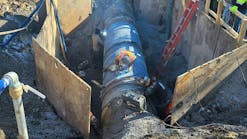Water infrastructure failures across the country — including water main breaks, flooding from overwhelmed stormwater systems, and damaged dam spillways — demonstrate the urgent need to reinvest.
WASHINGTON, DC, MARCH 24, 2017 -- A new report finds that closing the nation's gap in investment in water infrastructure would create 1.3 million jobs and generate $220 billion in economic activity.
The analysis also found a severe economic cost to inaction. At a national level, a one-day disruption in water service can lead to a loss of $43.5 billion in sales and $22.5 billion in GDP. At the local level, industries most reliant on water would see sales drop by up to 75 percent due to a one-day disruption in service.
The report, "The Economic Benefits of Investing in Water Infrastructure" was commissioned by the Value of Water Campaign to better understand how investments in the nation's water infrastructure affects economic growth and employment. The Water Environment Federation (WEF) is a founding member of this national awareness effort that seeks to advance positive solutions to America's pressing water challenges.
To maintain reliable clean water services alone, the American Society of Civil Engineers estimates that the U.S. needs to invest an additional $82 billion in water infrastructure per year over the next decade at all levels of government. Those capital needs are dispersed across the country, including the Midwest (23%), Northeast (20%), South (34%), and West (23%).
Despite this increased need, the report finds that the federal government's contribution to water infrastructure continues to decrease. Federal investment averages just nine percent in recent years, which is down from more than 60 percent 40 years ago.
"Although we were pleased to see a proposed FY 2018 Budget Request that includes a slight increase to water infrastructure funding programs, it still falls short of the billions that are needed to modernize our systems and to maintain the quality and service that our communities are accustomed to receiving," said WEF Executive Director Eileen O'Neill. "Inadequate investment in our water infrastructure as well as reductions in funding for watershed protections and water-related research pose a real threat to our water resources and our quality of life."
The report release coincided with World Water Day and Water Week -- global and national efforts designed to bring attention to the value and importance of clean water, which is essential to the protection of public health, the environment, and a growing economy.
The analysis falls against a national backdrop of increasingly complex water challenges that are exacerbated by overstressed and antiquated drinking water, wastewater, and stormwater management systems as well as regulatory requirements that at times outpace the technological capabilities of the nation's water and wastewater facilities.
"The report findings make it clear that investments in water infrastructure generate high quality jobs, increases the competitiveness of American businesses, and leads to a significant injection of economic activity throughout the nation," said Radhika Fox, Executive Director of the Value of Water Campaign. "That is the message we want public officials on Capitol Hill and across the country to hear: Investing in water equals jobs. Investing in water infrastructure builds a prosperous America."
Read the full report here.
About the Value of Water Campaign
The Value of Water Campaign educates and inspires the nation about how water is essential, invaluable, and in need of investment. Spearheaded by top leaders in the water industry, the Value of Water Campaign is building public and political will for investment in America's water infrastructure. To learn more, visit www.thevalueofwater.org.
About WEF
The Water Environment Federation (WEF) is a not-for-profit technical and educational organization of 33,000 individual members and 75 affiliated Member Associations representing water quality professionals around the world. Since 1928, WEF and its members have protected public health and the environment. As a global water sector leader, our mission is to connect water professionals; enrich the expertise of water professionals; increase the awareness of the impact and value of water; and provide a platform for water sector innovation. To learn more, visit www.wef.org.
RELATED ARTICLES
Infrastructure Funding: Where Do We Go From Here?
Rejuvenating America's Water



